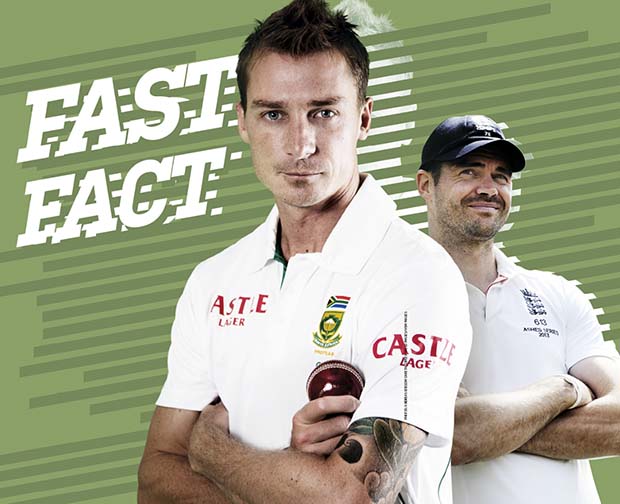SA Cricket magazine explored the Steyn versus Anderson debate a year ago, in our September-October 2013 issue, and the decision was unanimous: Steyn is the best. By Gary Lemke
It says much for the perception in England that James Anderson is ahead of Dale Steyn in the pecking order of the world’s Test opening bowlers that the influential Wisden Almanack, the ‘bible’ of the sport, named him one of five Cricketers of the Year back in 2009. Steyn had to wait four more years to finally receive his recognition – and only after South Africa had gone to England in that glorious summer of 2012 and showed them who’s boss.
Anderson was recognised after his 34th Test match, whereas Steyn only got his ‘call-up’ after his most recent, his 65th, where his 4-80 against Pakistan at Centurion earlier this year took his career haul to 332. They have come at an average of 22.65 runs per scalp and includes 21 five-fors and five 10-wicket match hauls.
Anderson had played in 86 Tests and had taken 324 wickets going into the final Ashes encounter. His strike rate was 30.20, and he’d taken 15 five-fors and two 10-wicket match hauls. In a game where statistics drive so many conversations, Steyn is some distance superior to Anderson, yet it was the Englishman who got his Wisden recognition in 2009. Go figure.
Not that gongs and accolades matter that much to Steyn. Back in August, while Anderson was shaking hands with the Queen during the Ashes series, the South African was in Hollywood where he performed a cameo in Blended, a new film starring Adam Sandler – and he shared quality time with the comedy actor. He was even invited to Sandler’s Los Angeles home for supper. ‘When I walked in he was wearing the Proteas shirt. That was pretty cool,’ he recalls.
And while England were tearing through the Australians, Steyn was taking time out to rest from injury. ‘I enjoy surfing, so I stayed at Huntington Beach near LA and went to watch the US Open surf competition,’ says Steyn.
Now he’s ready to go, nearly 10 months after he was last seen in Test whites. He should spearhead the Proteas attack against Pakistan in Abu Dhabi and Dubai and when he last played there, in November 2010, against the same opposition, he took two wickets in the first Test and four in the second. A fast bowler’s paradise the UAE certainly ain’t.
The break he has had – those 10 months – is similar to the one in 2007 when he returned from a lay-off to take 2-50 and 5-56, also against Pakistan, in Karachi.
In 2011 he also had a 10-month hiatus and returned with 4-55 and 2-23 against the Australians at Newlands. History has shown he is able to shake off the ring rust quite quickly, although South Africans will be looking to bigger and better things from him in the coming months. Like India at the end of the year and then Australia early in 2014.
By then the man they call the Steyn Remover should be right back to his fiery best – and in the type of mood that saw him rip through India when they last visited South Africa at the tail of 2010. On that occasion he claimed 21 wickets in the three Tests.
Anderson, by contrast, saw his form dip away badly in an Ashes series where England put their foot on the Australian throats early on – and kept it there. By the end of the fourth Test, with the hosts already having a winning 3-0 lead, Anderson looked out on his feet, exhausted.
He had claimed a 10-for in the narrow win at Trent Bridge, but then had three matches where his returns were three, two and two wickets respectively.
By that stage he was clinging on to the top 10 in the ICC bowlers’ rankings, while Steyn and countryman Vernon Philander were flying that South African flag high at No 1 and 2 ahead of the series against Pakistan.
Still, there are those who are adamant that when it comes to a comparison of England’s finest opening bowler with South Africa’s, it’s worthy of considered debate.
Wasim Akram, the legendary Pakistan left-armer, reckons it’s Anderson. ‘He leads from the front,’ he says. ‘For me he is the best bowler of this era. He does it consistently, with the new and the old ball. I have seen Dale Steyn bowling with the old ball and he only bowls one delivery – the inswinger to the right-hander.’
He continues: ‘Steyn is one of the best in the world, but Jimmy is slightly ahead because he does a lot more with the old ball. Jimmy is up there with me and Waqar [Younis] because of the control he has. He was always good with the new ball, but with the old ball he is intelligent. He bowls five away-swingers, then one inswinger and takes a wicket.’
Anderson himself earlier this year seemed sheepish when another voice, England bowling coach David Saker, backed his bowler. ‘To me, he is the most skilful fast bowler in the world,’ Saker said.
‘I know Dale Steyn is an outstanding bowler, but when you watch the way Jimmy goes about things, he has more skills in his locker. Steyn might be a little quicker but watch Anderson deliver those skills and it’s just mind-blowing.’
In reply, Anderson shied away from such lavish praise and opined that he was still some way short of the South African.
Despite all the stats and, let’s face it, a good dollop of plain common sense suggesting Steyn is the premier fast bowler in the world and in line to become one of the best of all time, perhaps a better comparison is how integral they are to their respective sides.
Take Steyn out of the Proteas Test firing line and you’re left with Philander, Morne Morkel, maybe Rory Kleinveldt, Jacques Kallis and a few part-timers. His absence leaves a huge void in the South African line-up and without him the opposition batsmen suddenly seem to grow two feet taller.
Anderson misfired in three of the four Ashes Tests but still England were too strong for an outgunned Australian side. Stuart Broad produced one of the better Test spells in recent years to set up a resounding victory in Durham, while Graeme Swann’s off-spinners give England a proper slow strike bowler.
In fact, the England selectors strongly considered – with the series won – resting Anderson for the final Test. If the South Africans did that with Steyn, the strike force would become severely diminished, and that is showing no disrespect to his team-mates like Morkel and Philander. It’s just that Steyn has been such an integral part of the Proteas’ rise to No 1 in Test cricket.
Someone like Wasim might reckon Steyn is a one-trick pony, but former England captain Michael Vaughan won’t agree. Those two deliveries that saw him getting bowled in 2004 and 2008 remain favourites on any highlights reel, while Steyn’s 300th Test wicket came via the New Zealander Doug Bracewell.
In fairness to him, it was wasted on the Kiwi. That ball would have got out any batsman in the world.
Anderson does bowl particularly well with the old ball, but much of his success with the new nut has been aided by seamer-friendly tracks in England and a good deal of swing and sideways movement.
Perhaps, for the neutral, the swaying factor is the memories. Steyn’s downward fist pump celebrations after uprooting a stump get the crowd on their feet. There are few finer sights than seeing the timber rearranged and a fast bowler enjoying total domination in what has become a batsman’s game. Speed still thrills.
When in the zone he is virtually unplayable and he’s getting even better under the watchful eye of Proteas bowling coach Allan Donald. A sign of Steyn’s greatness is that, of all the fast bowlers to have reached 300 wickets, only the Australian speedster Dennis Lillee got there in fewer Tests. Steyn versus Anderson? Here in Saffa-land there’s only one winner.
This feature was originally published in issue 121 of SA Cricket magazine.







